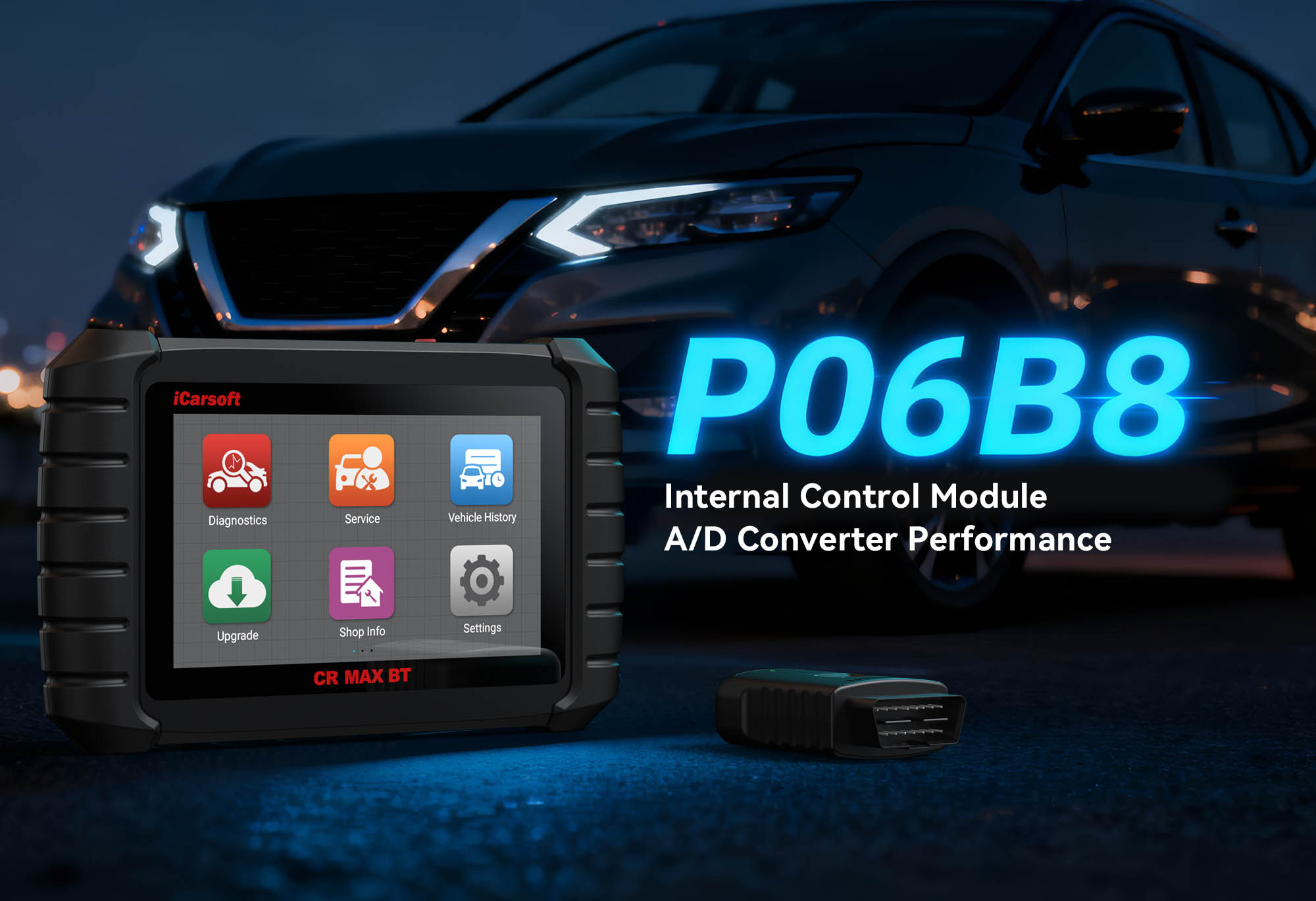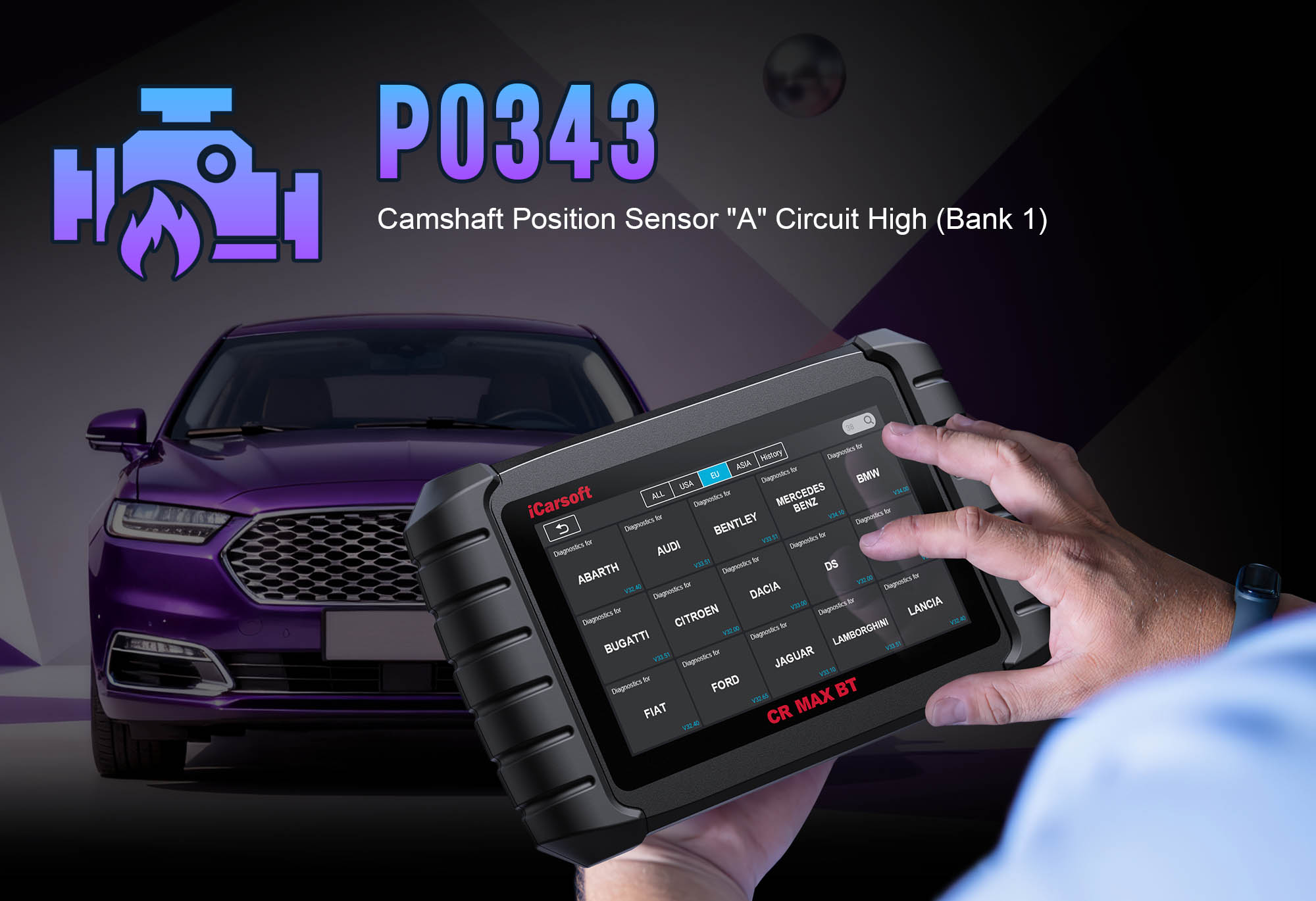Understand & Fix P2110: Throttle Actuator Control System - Forced Limited Power with iCarsoft CR Pro S
If your vehicle suddenly goes into "limp mode," loses acceleration power, or displays a "Reduced Power" warning light, a diagnostic scan will likely return P2110. This critical OBD-II code stands for "Throttle Actuator Control System - Forced Limited Power," targeting the electronic throttle control (ETC) system. The ETC replaces traditional mechanical throttle links, using a motorized actuator to regulate airflow based on driver input and engine demands. When the Engine Control Module (ECM) detects a malfunction in the throttle actuator’s circuit or movement, it triggers limp mode to prevent engine damage—restricting RPM and acceleration.
Basic scanners might only flag "throttle system error" but can’t test actuator responsiveness, verify circuit integrity, or recalibrate the ETC—leaving you stranded or guessing between a faulty actuator, wiring issues, or a failing ECM. The iCarsoft CR Pro S, with its OE-level engine diagnostics, bi-directional control, and ETC-specific calibration tools, solves this. Below, we break down P2110, its causes, symptoms, step-by-step resolution, and 8 FAQs to answer common troubleshooting questions.
What Is P2110?
P2110 focuses on the throttle actuator control system, which includes the electronic throttle body (ETB), throttle position sensors (TPS), wiring harness, and ECM. The throttle actuator (integrated into the ETB) adjusts the throttle plate opening in response to ECM signals. A "forced limited power" error means the ECM has detected an irrecoverable fault—such as unresponsive actuator movement, erratic TPS signals, or circuit shorts—prompting it to limit power to protect the engine.
This code is common in vehicles with drive-by-wire systems (e.g., Ford, Toyota, Honda, BMW), and resolving it requires precise diagnostics to avoid misdiagnosing costly components like the ECM.
Key Symptoms of P2110
-
Limp Mode Activation: Vehicle limits speed to 30–40 mph and RPM to 2,000–3,000, with reduced acceleration.
-
Illuminated Warning Lights: Check Engine Light (CEL) and "Reduced Power" or "Engine Power Reduced" dashboard message.
-
Rough Idling or Stalling: Erratic throttle plate movement disrupts idle stability, especially at startup.
-
Unresponsive Gas Pedal: Pressing the pedal yields little to no acceleration due to ECM-restricted throttle input.
-
Cold Start Issues: Harder cranking or prolonged warm-up from uncalibrated throttle actuator.
-
Increased Fuel Consumption: Imbalanced airflow leads to inefficient combustion, even in limp mode.
Common Causes of P2110
|
Cause
|
Description
|
|
Faulty Electronic Throttle Body (ETB)
|
Worn motor, stuck throttle plate, or internal sensor failure in the actuator.
|
|
Throttle Position Sensor (TPS) Malfunction
|
Erratic signal from TPS (integrated into ETB) misleading the ECM.
|
|
Wiring/Circuit Issues
|
Frayed wires, corroded connectors, or loose terminals disrupting power/signals to the ETB.
|
|
Dirty Throttle Body
|
Carbon buildup on the throttle plate restricting movement and sensor accuracy.
|
|
ECM Software Glitch or Failure
|
Outdated software or internal ECM faults preventing proper throttle control.
|
|
Low Battery Voltage
|
Insufficient power to operate the throttle actuator (common in older vehicles).
|
Why iCarsoft CR Pro S Excels at Diagnosing P2110
The CR Pro S outperforms basic tools with features tailored to ETC system diagnostics—critical for resolving P2110 without guesswork:
Bi-Directional Throttle Actuator Testing
Sends open/close commands to throttle plate, verifying responsiveness—distinguishes ETB from wiring/ECM faults.
Live TPS & Throttle Position Tracking
Monitors TPS voltage and throttle plate angle in real time, highlighting erratic signals triggering P2110.
Global Vehicle Coverage
Supports 50+ brands with drive-by-wire systems, including hybrid, diesel, Ford F-150, Toyota Camry, BMW 3 Series.
Electronic Throttle Control Relearn
Calibrates ETB after cleaning/replacement—eliminates post-repair adaptation issues.
Circuit Continuity & Voltage Checks
Built-in multimeter tests for shorts, opens, and voltage drops in the ETB circuit.
ECM Reset & Software Updates
One-click ECM reset and lifetime free software updates to fix glitches causing P2110.
Step-by-Step: Diagnose P2110 with iCarsoft CR Pro S
-
Confirm P2110 & Gather Vehicle-Specific Data
Plug the CR Pro S into your vehicle’s OBD-II port, power on the tool, and select AutoVIN Identify to auto-detect make, model, and ETC configuration.
Navigate to Engine > Fault Codes > Read Codes to confirm P2110. Tap Code Details for model-specific insights (e.g., "Ford Focus: Throttle Actuator Control System Forced Limited Power; TPS Voltage: 0.1V, Expected: 0.5–4.5V; Check ETB or Wiring").
-
Analyze Live ETC System Data
Go to Engine > Live Data > Throttle Control and monitor three key metrics:
1. TPS Voltage: Fluctuates with pedal input (0.5V at idle, 4.5V at full throttle). Fixed/out-of-range values confirm P2110.
2. Throttle Plate Angle: Matches pedal input (0° at idle, 90° at full throttle)—mismatch = actuator failure.
3. Battery Voltage: Ensure 12.4–13.8V (low voltage disrupts actuator operation).
-
Test the Throttle Actuator & Circuit
1. Use Bi-Directional Control > Engine > Throttle Actuator Test: Send open/close commands. Listen for whirring and check TPS voltage adjustment. No response = faulty ETB.
2. Locate the ETB: Use the CR Pro S’s Component Location tool (typically on intake manifold).
3. Inspect & Test: Check for carbon buildup, damage, or leaks. Use Resistance Test (match OEM specs, e.g., 10–30 ohms—open/infinite = faulty ETB).
-
Inspect Wiring, Clean Throttle Body, & Update ECM
1. Wiring Check: Use Continuity Test on ETB wiring for breaks/shorts. Focus on engine/heat or battery/corrosion areas.
2. Throttle Body Cleaning: Remove and clean with throttle cleaner. Use Electronic Throttle Control Relearn post-cleaning to calibrate.
3. ECM Update/Reset: Use CR Pro S to reset ECM (clear adaptive data) or update software (fix glitches via Wi-Fi with lifetime free updates).
-
Repair & Validate the Fix
- Replace faulty ETB or repair wiring if defective. Reconnect battery and use CR Pro S to Clear Codes.
- Run Throttle Control Validation Test (under Special Functions) to confirm actuator response to pedal input.
- Test drive to verify limp mode is disabled, acceleration is restored, and P2110 doesn’t return. Monitor live data for stable TPS voltage and throttle plate movement.
FAQs: P2110 Troubleshooting (With Low-Competition Long-Tail Keywords)
Can I drive with P2110 limp mode?
Limp mode is designed for emergency travel only—prolonged driving risks engine overheating or stalling. Use the CR Pro S to diagnose immediately, especially if you’re dealing with P2110 Ford F-150 reduced power or Toyota Camry throttle actuator malfunction.
How much does it cost to fix P2110?
A new electronic throttle body costs $150–$400, plus $100–$200 for labor. Cleaning + relearn adds $80–$150. The CR Pro S saves on diagnostic fees ($100–$250) and avoids misreplacing the ECM (costing $500+).
Why does P2110 keep returning after clearing codes?
The root cause wasn’t addressed—common culprits include dirty throttle body P2110 Honda Civic (carbon buildup) or hidden wiring damage. Use the CR Pro S’s History Log to track recurrence and live data to pinpoint unresolved issues.
What’s the difference between P2110 and P2112 (Throttle Actuator Control System Stuck Closed)?
P2110 = forced limited power (ECM restricts operation), while P2112 = throttle plate stuck closed (severe no-start risk). The CR Pro S’s code details distinguish these, with bi-directional testing to confirm plate movement.
How do I fix P2110 without replacing the throttle body?
Try cleaning the throttle body (use CR Pro S’s relearn function) or checking wiring. For P2110 BMW 3 Series or Volkswagen Golf throttle control glitch, an ECM software update via the CR Pro S may resolve the issue.
Do I need to relearn the throttle body after replacement?
Yes—skip this step, and P2110 will return. Use the CR Pro S’s electronic throttle control relearn (supports 56 vehicle makes) to sync the new ETB with the ECM.
Can low battery voltage cause P2110?
Absolutely—insufficient power disrupts the actuator’s motor. Test battery voltage with the CR Pro S, especially if you’re troubleshooting P2110 older vehicle reduced power (common in high-mileage cars).
Will P2110 damage my engine?
Limp mode protects the engine, but unresolved faults (e.g., stuck throttle plate) can cause misfires or overheating. Fix P2110 promptly with the CR Pro S to avoid costly repairs like throttle actuator motor replacement or ECM damage.
Conclusion
P2110’s forced limited power fault is frustrating, but the iCarsoft CR Pro S simplifies diagnosis with bi-directional testing, live data tracking, and ETC calibration tools. It ensures you target the root cause—whether it’s a dirty throttle body, faulty actuator, or wiring issue—instead of wasting money on unnecessary parts.
With a 5-inch touchscreen, lifetime free updates, and coverage for 50+ brands, the CR Pro S is a must-have for DIYers and mechanics dealing with drive-by-wire systems. Resolve P2110, restore full power, and avoid limp mode emergencies—all with one professional-grade diagnostic scanner.





